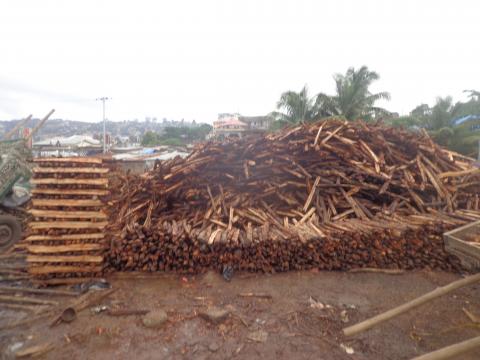By Mohamed Jaward Nyallay
It is common knowledge among many that felling trees for wood and charcoal destroys the environment. The government is expected to lead the country to a clean cooking energy source in the future but ironically it is one of the biggest users of wood and charcoal.
Most government-run kitchens in Sierra Leone use either firewood or charcoal; from military barracks, to hospitals to prisons.
According to Environmental Network News, every year Africa loses a forest cover equal to the size of Switzerland.
In a country where different studies have shown that at least up to 90% of the population is poor, the use of charcoal and firewood becomes more about survival than choice. People in this bracket can even use cheaper options. In a village like Gambia, three miles away from the southern town of Mattru Jong, during the rains people use palm nut waste products as their fuel for cooking.
Considering other options as a cooking fuel source becomes very difficult when one knows that options like electricity supply is erratic at its best; kerosene is unavailable in the market and gas is still perceived as expensive by many locals.
The desire to continue feeding this growing demand for cooking fuel is perhaps the most progressive environmental threat Sierra Leone is facing.
According to United Nations Environmental Program (UNEP), more than 40% of the energy produced in Africa is provided by wood and charcoal.
Government figures show that more than 80% of Sierra Leoneans use charcoal or firewood for cooking. Wood and charcoal are cheap, locally available and easy to use. This makes it easy for anyone to decide to use them.
According to Peter Mannah, Business Development Manager at Afrigas, the number might even be higher.
“Only 5% to 7% of Sierra Leoneans use gas as their cooking fuel. A huge proportion of those users are based in the Western Area,” Mannah said.
Afrigas is the leading gas bottling company in Sierra Leone.
As urbanization has increased in the last decades, the demands for cooking fuel products have increased.
“Two or three decades ago we had about 85% of our land covered with primary forest. But give or take; now it is only about 5%,” Joseph Rahall, Executive Director of the environmental campaign group, Green Scenery, said.
Joseph’s assessment paints a grim picture of how much forest the country has lost to urbanization and other factors.
Green Scenery is one of the oldest green groups in Sierra Leone. It was established in 1989 and since then they have embarked on series of campaign and research work to make the environment better. Today the organization is focused on higher level advocacy.
Focus on charcoal
For a huge part of Sierra Leone’s history, most people have depended on firewood for cooking. But after the civil war, charcoal production gradually started to increase. This was so because some people thought that the business was more lucrative than farming for example.
Today many women prefer using charcoal than wood. Charcoal burns faster and produce far less smoke than wood. It is important to note that wood and charcoal production destroys the environment but charcoal is a whole new level of deforestation.
Wood and charcoal production destroy animal habitat, expose the land to erosion and the carbon emission from both products pollutes the oxygen in the environment.
There are different methods of producing charcoal. In Sierra Leone the most common method used is the earth mound method. This is done by chopping the trees in to logs and burying them in a pit whiles setting it alight. The fire is expected to burn at a degree of about 400 to 600 centigrade without any oxygen to support it. The process is known as carbonization.
Because most of the people who produce coal do not have specialized knowledge about it, the felling of trees for charcoal production has been indiscriminate.
“Charcoal is one of the most consuming entities for deforestation. You have to compress a huge amount of wood to produce small amount of charcoal,” said Rahall.
Hanging on to the money
Thousands of families depend on firewood and charcoal production across Sierra Leone. It is not clear how much exactly the trade is worth in the country, because there are no mechanism in place to keep track of how many bags of charcoal or piles of wood are produced in the country within a period of time.
The capital, Freetown, gets a huge bulk of its firewood and charcoal from the northern region of the country, especially Port Loko. Trucks transport wood in to the city from nearby villages. Boats also bring in huge amount of wood and charcoal.
At Congo Town wharf, the Harbor Master, Alusine Kamara, told me that in a very good business week they get as much as 500 bags of charcoal and 3000 bunches of wood offloaded on to shore.
Even the most conservative calculation of how much wood and charcoal comes in Freetown through Congo Town wharf in a month, would show a staggering figure.
Perhaps the most worrying thing is the level of dependence on the industry.
Like many other women in the community, Mariatu Kabba sells charcoal and wood. She is a mother of eight children and she told me that she depend on what she makes for a day.
“I cannot afford to save money because I do not make enough. We eat what we make for the day,” Mariatu said.
According to her, on her best selling day she can only make Le50, 000 (just over $7). With a family of eight, it is difficult to imagine how much they could eat and at the same time support the kids to go to school. Her testimony makes a strong case of how dependent people are on a trade that is destroying the environment at a neck-breaking speed.
Even with such huge amount of charcoal that comes in to their Congo Town wharf, one would expect people like Mariatu to make a decent profit to support her children, but that is not the case.
As per their mandate, Freetown City Council charges business people Le500 per bag of coal. A bag of coal at the wharf sells from 10 to Le12, 000.
“I collect these monies on behalf of the council and yet I don’t get a salary,” Kamara, the harbor master, lamented.
Cooking, earning and saving the environment all together?
Establishing the environmental threat of using wood and charcoal for cooking is very important. Establishing the level of dependence on the industry is also very important. Going forward, policy makers have to consider how to continue cooking, whiles providing livelihood for families and saving the environment; all at the same time.
Perhaps the most common solution would be to ban charcoal production and the felling of trees for wood. The Gambia has a ban in place against charcoal production.
But doing so in Sierra Leone would drastically affect millions of homes.
In Tanzania, charcoal is a multi-million dollar industry. In 2006 the trade got so rampant that the government decided to ban both production and trade. This only worsened the situation, because coal was still produced and sold (hidden). This led to the commodity been very expensive because of the new sense of danger that came with producing it. The ban only lasted for two weeks and it was lifted.
Kenya had a similar experience.
In Sierra Leone the approach has to be different. The Forestry department at the Agriculture Ministry has shown concerns towards massive production. As much as they cannot stop it but they have been collaborating with wood and charcoal producing communities to produce sustainably.
In 2015, the National Revenue Authority collaborated with the Forestry Department to launch a project at Gbomsama Village, 123 miles away from the capital. The project was focused on how to replenish the environment while producing charcoal.
In replenishing, fast growing species of trees like Acasia and Galiptos have been introduced.
In Ghana, the future is Bamboo.
Like Sierra Leone, Ghana has a worrying trend of deforestation as a result of wood and charcoal production. In tackling deforestation and sustaining charcoal production they have turned to Bamboo as a solution.
Bamboo is arguably the fastest growing tree in the world. According to African Business’s publication on the web, one can grow a Bamboo forest in three years; whiles a typical rain forest could take six decades to be fully matured.
This is something that Sierra Leone must adopt.
Alternative livelihoods would be important in fighting deforestation. People like Mariatu could jump at a chance to have an alternative livelihood.
“If I have another option I will not sell wood or charcoal. Even though I have ideas but I don’t have a startup capital,” she said.
Going forward, more campaigns need to be done to change the perception of people about gas as a cooking energy source.
“The use of a 12kg gas bottle could save nearly a 100kg of charcoal and 800kg of wood plus a zero toxic carbon,” argued Peter.
The Sierra Leone government has encouraged businesses that import kerosene stoves and gas cookers by giving them tax concession. This was done in the Finance Act of 2011.
Wood and charcoal are the byproducts of the environment; cooking with them is like cooking with the environment and protecting the environment is very important for the future.
© Politico 2016









